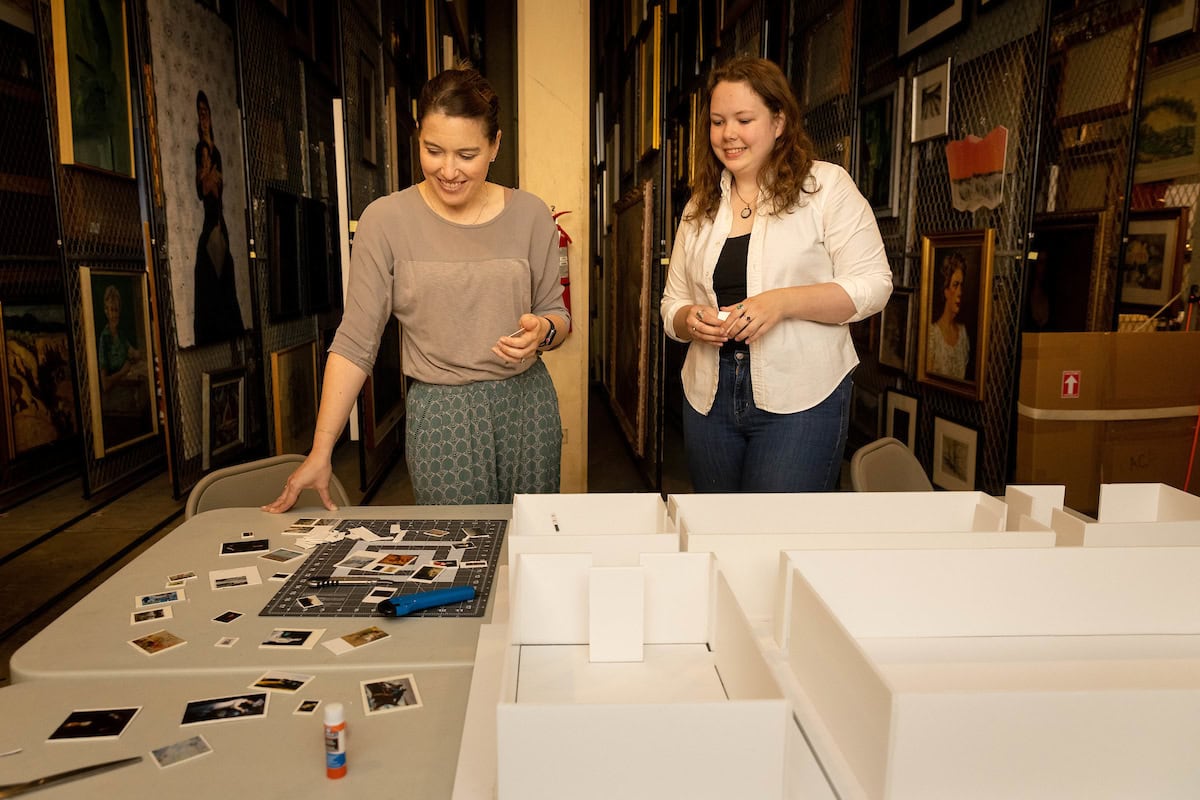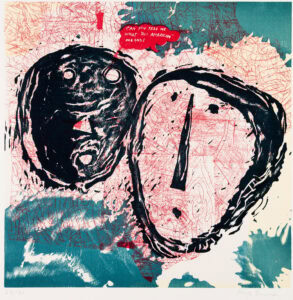Randolph professor, student develop art reinstallation proposal for the Maier
This story is part of an ongoing series featuring the work of faculty and students participating in Randolph’s Summer Research Program.

Lesley Shipley and Elizabeth Bailey ’25 are developing a proposal to reinstall works in one of the front galleries at the Maier Museum of Art at Randolph College.

Jaune Quick-to-See Smith’s “All American” (1996)
Artist Jaune Quick-to-See Smith’s All American poses a question that inspired Lesley Shipley’s Summer Research Program project: What does it mean to be all-American?
Shipley, an art history professor, and Elizabeth Bailey ’25 are developing a proposal to reinstall works in one of the front galleries at the Maier Museum of Art at Randolph College, where the College’s permanent art collection is displayed.
“Smith’s question, for me, was a great way to frame the exhibition because we’re thinking about what all-American meant when this collection was first starting and how that has changed,” Shipley said about Smith’s piece, which is part of the permanent collection. “And how can we tell that new story with a reinstallation?”
The installations in the Maier’s front three galleries are laid out chronologically, highlighting the College’s collection of art from the 19th, 20th, and 21st centuries.
“It gives you a sense of the stylistic changes that happened across time, and a lot of the work was really contemporary for the time period it was purchased,” Shipley said.
The collection has grown, and their idea for Gallery 1 proposes juxtaposing contemporary and historical American art to raise questions and encourage dialogue about how the concept of all-American has been defined, challenged, and revised by American artists since the 19th century.
“The historical art in conjunction with the contemporary art creates an interesting conversation that helps the work be more relevant for people today,” said Shipley, who approached Bailey about working with her this summer.

Elizabeth Bailey ’25
Bailey, an art history major, jumped at the chance.
“This project does a lot of things, but it reinvigorates the idea of the museum,” she said. “I want more of the collection to be seen, and I also want it to be more representative of artists who the students could relate to. I really wanted to be a part of it.”
Bailey also works at the Maier and leads the student docent club FRAME.
“I somehow inserted myself in all facets of the museum, which is great for this project because I have a technical understanding of what goes on,” Bailey said. “I’ve been very fortunate to have hands-on experience with handling objects and the care tasks involved.”
They began their journey with research on museum best practices and then took trips to other museums—the Asheville Art Museum, Reynaldo House Museum of American Art, and the North Carolina Museum of Art—that have recently reinstalled work.
“It’s becoming kind of a trend now, to reinstall or rethink permanent collections, especially in regards to American art,” Shipley said.
Laura McManus, the Maier’s curator of education, accompanied them to each museum.
“Collaboration is a big deal, and curators should work directly with museum educators,” Shipley said. “Laura graciously gave up her time to come with us to look at these exhibitions and talk to us about what they were doing. We got a lot of really good ideas.”
Shipley and Bailey also pored through the collection itself to come up with a list of art to include and created a 3D model illustrating their proposed reinstallation for Gallery 1. They’ve also kept a list of ideas for Gallery 2 that could carry on the narrative they’re creating.

Lesley Shipley and Elizabeth Bailey ’25 work on their 3D model for the reinstallation proposal.
“It’s more than just deciding what you want it to look like,” Bailey said. “It’s about what you want people to glean from this, what you want the statement to be, and how it relates to the mission of the museum.”
Their proposal includes two pieces that are already on display, alongside a mix of old and new acquisitions.
“Some of it will still be 19th century, but pieces that haven’t been out in awhile, or maybe have never been out,” Shipley said. “And we’re including new mediums, lille photography. We want a real range.”
Bailey has been the ideal partner for the project, she said.
“She thinks critically about art history, and I knew she could hit the ground running with me,” Shipley said. “I also really appreciate Elizabeth’s willingness to give me her opinion about things. She’s diplomatic, but she’s honest. And I really wanted to do this with a student. This museum is for them.”
Tags: art, art history, Lesley Shipley, Maier Museum of Art at Randolph College, museum and heritage studies, summer research, summer research 2023
